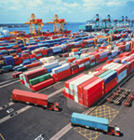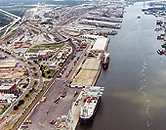It was a start, but the ports had filed grant applications for $750 million worth of work, eight times the total Mineta promised. According to the American Association of Port Authorities, ports have plans to spend at least $312 million of their own money for security enhancements. The U.S. port industry is pushing for another $125 million in grants, as well as solid security guidelines from the government.
 |
| A GLANCE Only 2% of cargo containers get screened for content at U.S. ports. (Photo courtesy of Getty Images/Lester Lefkowitz) |
FROM AIR TO SEA
U.S. airports have grabbed the lead in national concern about infrastructure-related terrorist targets, but marine ports are next in line. Over 17,000 containers carrying nearly 2 billion tons of cargo arrive daily at the country's 361 deep-water seaports. With intermodal connections to road, rail and utilities, the marine transport sector faces big challenges of design, construction and operations. And as with their aviation counterparts, ports in many cases have had to put their capital plans on hold while awaiting legislation that will provide security guidelines.
Engineers and planners who work with ports encourage a uniform, globally compatible set of standards for implementing new procedures and technology. The impact on infrastructure varies from port to port, but "there's no doubt that business has changed [and] any future expansion will have the security issue," says Byron Miller, spokesman for South Carolina's Port of Charleston. "Terminals won't be built the same."
Closed-circuit cameras, pull-aside spaces for closer inspection of trucks, gamma ray machines, higher fences, even widened roadways are some of the security measures that ports are implementing now with the help of the grants. But "we don't know what the full impact will be from security mandates that have yet to be developed on a national level," says Phil Crannell Jr., Florida-based director of the ports and maritime group for CH2M Hill, Denver, Colo. "In many cases where possible, ports are delaying the implementation of normal projects." For instance, Tampa and Port Everglades each shifted some $20 million from infrastructure plans to a security budget, he says.
A House bill calls for three years of grants totaling $249 million, while a Senate counterpart calls for $390 million in grants over five years. Port officials are concerned about a proposed security tax related to the bills and about the prolonged time it is taking to receive concrete security requirements. "We're encouraged that [Congress has] made it to the conference round," says Beth Rooney, director of ports for the Port Authority of New York and New Jersey.
But until the government comes down with mandates, ports are proceeding cautiously with security-related infrastructure work. "Without some sort of consistent ‘here's the things you need to look at' policy, nobody can put a price tag" on port security requirements, says Edward J. Schmeltz, head of ports for DMJM+Harris, New York City. "Who's going to put the money up? That needs to shake out."
Rooney compares the situation to the aviation guidelines requiring airports to install baggage screening machines by Dec. 31–a deadline and a requirement that did not go over well with many airport officials. "While we're pushing for this [legislation] to get done, we'd rather they take the time to do it right," she says. "But we do need something–a policy, and to identify who's in charge and where the money is to go along with it."
Boyle says that some ports are concerned that legislation may call for fixed scanners, but "it would be relatively easy at Oakland, because we have only three access points." Oakland is spending up to $80 million to add fencing, lighting, video cameras and a gamma radiation scanner, with another due in October.
Alabama State Port Authority has restrictive regulations for port entry and access and developed a $2-million set of security improvement proposals. A state-of-the-art credential system would be integrated with a cardholder management system and linked to automated access gates. Camera surveillance systems would track personnel, vessel and vehicle movement, says James K. Lyons, director and CEO of Mobile's Alabama State Docks. "[We] plan even more expansion of that program," he adds.
The Port of Corpus Christi, Texas, one of the nation's five largest, is using its $2.27-million grant for security measures that include a new security command center, infrared remote-controlled TV, surveillance cameras for the waterway; fiber optic links and military equipment lay-down areas, fingerprinting system with access to background investigations and smart ID card systems, says port commission Chairman Ruben Bonilla.
In New York, the port authority is spending some $60 million of its capital budget for security measures in its public areas. Fence height will increase from 6 ft to 10 ft, and intrusion detection systems, closed-circuit TV and a new operations center will be built. The port plans to widen roadways to increase capacity in case of evacuation onto the highways. Rooney adds that the port has received $2 million for pilot projects that test technology for chemical/biological weapons detection, container scanning, electronic sealing and ID and X-ray inspection.
 |
| MOBILE Port is buying a range of security tools. (Photo courtesy of Alabama State Docks Department) |
SAFETY WITH A PRICE TAG
Despite their traditionally competitive atmosphere, ports are starting to share information about new technology and other efforts, says David Cruz, senior port planner for Moffatt & Nichol's Long Beach, Calif., office. "They're talking about biometrics, wireless equipment," he says. But new technology will be expensive. "A gamma ray machine can be $1 million to $3 million [and] perimeter surveillance could cost $2 million to $4 million," he says. And vendors, he notes wryly, will be glad to "help you spend as much as you want on security."
Inevitably, new technology and security procedures will take up room and change the layouts of ports. But much of that also depends on the unique characteristics of each port. Geographically, a port could have miles of coastline or be compactly snuggled into a harbor. For example, "the Port of New Orleans is one of the most difficult port facilities to secure in the nation," with 22 miles of waterfront, an unfenced perimeter and cruise ship terminals, notes Gary LaGrange, executive director of the port's board of commissioners. The port received a $3.78-million grant, though it had applied for $14.2 million to help defray the security costs taken from its operating budget.
The grant funds will be used to add electronic-access control gates at all four of its truck entrances in anticipation of carded access. The port will improve guard access at two entrances and add a lane for inspections and/or detaining vehicles. An 8-ft-tall industrial-grade fence to isolate the cruise ship terminals will be built.
Much of the infrastructure changes will occur at the gate–the point-of-entry facility, much like a highway toll plaza, that identifies and clears trucks entering with loads of cargo. In the case of increased inspection requirements, "how do you get, say, 500 employees through a gate in a short time?" asks Cruz. Modifications may include installing cameras atop gate canopies, pedestals to hold printers for issuing ID, and pull-over lanes for patrolmen to do further inspection of trucks. Gamma ray machines themselves are small–one can fit atop a crane–but the housing for related equipment typically could be 20 ft x 30 ft., notes Cruz.
Tracking people at the port is also an issue. Charleston is spending about $10 million in security technology at its port, with fencing, lighting and especially parking facilities "to track who goes where," notes Miller. Cruz points out that at Port Elizabeth, for example, three groups of port users–longshoremen, truck drivers and port employees–require three different levels of security.
"The biggest element that all ports would benefit from would be a nationally approved badging and ID system," says Crannell. "Also, we need a uniform standard for perimeter control."
Port officials cite Florida ports as being at least a year ahead of their counterparts because of a mandate issued in 2000 as an anti-drug trafficking initiative. "The procedures and requirements they had to follow...are on the road to being a national standard," says Crannell.
The Canaveral Port Authority has hired three diving teams to provide underwater inspections at Port Canaveral as another anti-terrorist method. Port Authority administrators recommended the action because the U.S. Coast Guard soon will require underwater inspections at cruise-terminal piers as part of anti-terrorism security measures. Costing up to $200,000 a year, the diving service went into place on Aug. 1.
Only 2% of incoming cargo is inspected in the U.S., but the key "is finding a way of separating high-risk cargoes from the vast majority of legitimate containers and dealing with the exceptions," says Rooney. Global cooperation between shippers, ports and authorities, increased training and new technology all are essential to this, she says.
On July 11, three of the world's largest seaport operators–Hutchison-Whampoa Ltd., PSA Corp. Ltd., and P&O Ports, representing over 70% of the world's container traffic, demonstrated deployment of automated tracking, detection and security technology for containers entering U.S. ports. The industry-driven initiative, "Smart and Secure Tradelanes," is to be operational by year's end. It will use real-time response information technology to improve tracking and security of shipments coming into the U.S. through electronic event-driven alerts, anti-tamper systems, virtual inspections and authenticated audit trails. Seattle-Tacoma will be the first domestic port to apply the program.
Crannell cautions that engineers should keep an eye on cost estimating as they help ports beef up security. Traditional infrastructure work will return, he says. "The non-security projects will eventually have to be undertaken in order for ports to continue to handle growing levels of commerce."
ne hot afternoon this June, standing in New York City's Battery Park, U.S. Transportation Secretary Norman Mineta told assembled reporters and onlookers that "it is impossible to overstate the importance of national maritime security." Flanked by members of the U.S. Coast Guard, city police and Port Authority of New York and New Jersey officials, he then announced $92.3 million in grants to be distributed to 77 U.S. ports.
Post a comment to this article
Report Abusive Comment